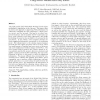Free Online Productivity Tools
i2Speak
i2Symbol
i2OCR
iTex2Img
iWeb2Print
iWeb2Shot
i2Type
iPdf2Split
iPdf2Merge
i2Bopomofo
i2Arabic
i2Style
i2Image
i2PDF
iLatex2Rtf
Sci2ools
SIGCOMM
1998
ACM
1998
ACM
Improving End-to-End Performance of the Web Using Server Volumes and Proxy Filters
The rapid growth of the World Wide Web has caused serious performance degradation on the Internet. This paper o ers an end-to-end approach to improving Web performance by collectively examining the Web components clients, proxies, servers, and the network. Our goal is to reduce userperceived latency and the number of TCP connections, improve cache coherency and cache replacement, and enable prefetching of resources that are likely to be accessed in the near future. In our scheme, server response messages include piggybacked information customized to the requesting proxy. Our enhancement to the existing request-response protocol does not require per-proxy state at a server, and a very small amount of transient per-server state at the proxy,
| Added | 05 Aug 2010 |
| Updated | 05 Aug 2010 |
| Type | Conference |
| Year | 1998 |
| Where | SIGCOMM |
| Authors | Edith Cohen, Balachander Krishnamurthy, Jennifer Rexford |
Comments (0)

